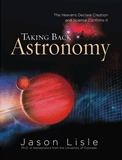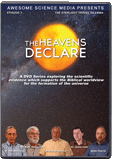
The Big Bang and Evidence for the “Inflation Theory”—A Preliminary Comment
The news media has been abuzz recently about supposed evidence that the universe expanded rapidly, growing to billions of light years across—all within the first trillionth of a second after its birth. A full treatment of this latest development in astrophysics is available at Have Cosmologists Discovered Evidence of Inflation?
The news media has been abuzz recently about supposed evidence that the universe expanded rapidly, growing from the size of a grape to something billions of light years across—all within the first trillionth of a second after its birth.
The finding by astrophysicists came via the WMAP (Wilkinson Microwave Anisotropy Probe), a NASA spacecraft. It supposedly backs the “inflation theory” (a part of the big bang theory). Inflation theories attempt to solve certain problems in the big bang scenario (such as the horizon problem). Inflation proposes that the universe underwent a temporary period of extremely rapid expansion early in its history. The WMAP can measure the temperature of the cosmic microwave background (CMB), which many secular astronomers interpret as radiation left after the big bang.
A magazine reporter recently asked Dr. Jason Lisle (an astrophysicist with AiG–USA) and AiG–USA president Ken Ham to comment on this development from a creationist perspective. Here were their answers:
Are you surprised by the findings?
No. Although most secular astronomers believe that the CMB is the result of a “big bang,” there is really no reason to believe this. Big bang supporters believe that tiny fluctuations in the CMB eventually became stars and galaxies. But such an idea comes from a belief in the big bang, and there is really no independent evidence to support this. Also, from a biblical perspective, there is nothing about CMB anyway that contradicts what creationists would say.
A spacecraft (called WMAP) measures these tiny fluctuations in the CMB. By measuring such properties, secular astronomers believe they can glean details of how stars and galaxies might have formed. There is nothing wrong with the WMAP measurements—this is evidence that is testable and repeatable in the present. It’s the interpretation that is faulty. Big bang supporters have an incorrect worldview, and so they draw an incorrect conclusion from the evidence.
Does this change anything in the creation vs. evolution debate?
No. This is really “much ado about nothing.” There are actually many different models of the big bang, each of which requires different parameters for the CMB. The latest WMAP results are roughly consistent with one of these big bang models. However, if WMAP had obtained a different result, the secular astronomers would simply have picked the model that was most consistent. In other words, no matter what WMAP would have found, big bang supporters would have claimed that it supports the big bang. As such, it really doesn’t prove anything. The latest WMAP results are fully consistent with biblical creation.
What is the relevance of this news story any way?
Most important, the big bang is expressly taught against in the Bible. The Scriptures say that the Earth was created first (Genesis 1:1—the first day of creation), and then the Sun was created (on the fourth creation day—Genesis 1:16). But the big bang says that the Sun came first and then the Earth. (By the way, during the first three days of creation there was light from a source different than the Sun—Genesis 1:3).
As we will proclaim in our new planetarium, when it opens later this year (inside the Creation Museum, also under construction) near Cincinnati, Ohio, if we start with God’s infallible Word and what it clearly teaches us about the history of the world, we can be confident that the big bang and other secular ideas (such as “molecules-to-man” evolution) are wrong.
Recommended Resources

Answers in Genesis is an apologetics ministry, dedicated to helping Christians defend their faith and proclaim the good news of Jesus Christ.
- Customer Service 800.778.3390
- © 2024 Answers in Genesis






